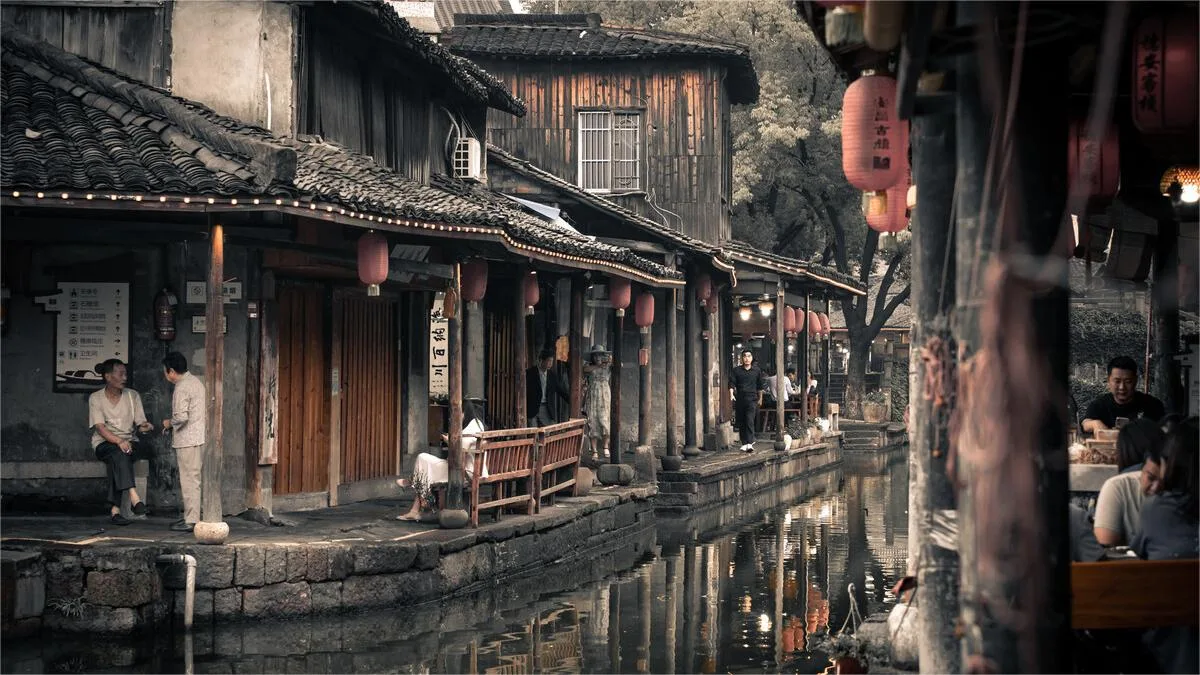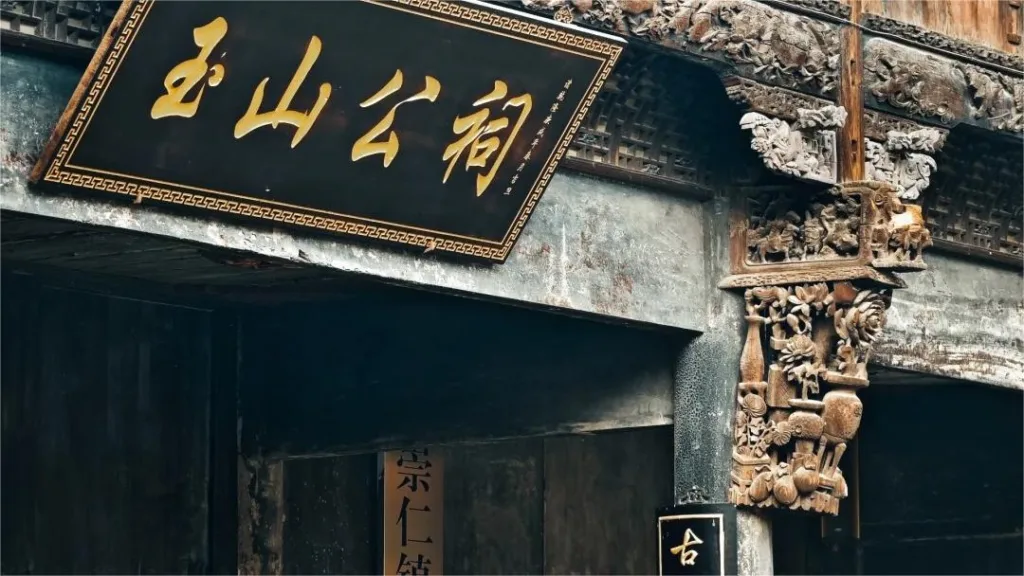Anchang Ancient Town (安昌古镇) is one of the renowned Four Ancient Towns in Shaoxing. Dating back to the Northern Song Dynasty, it has faced destruction multiple times due to wars but was rebuilt during the Ming and Qing Dynasties. The architectural style of Anchang Ancient Town embodies the typical characteristics of the Jiangnan water towns, with its picturesque setting along the riverbanks. The northern bank houses the commercial market, while the southern bank is dotted with residential buildings, connected by numerous stone bridges spanning across the waterways.
Anchang is renowned for its specialty products such as Anchang sausages, handmade white sugar candy, and soy sauce, which gained nationwide popularity after being featured on “A Bite of China.” During the three-day New Year festival known as the La Festival, visitors can immerse themselves in the local culture with traditional folk operas, folk singing performances, and lively waterborne wedding processions. Anchang Ancient Town serves as a living testament to Shaoxing’s rich cultural heritage, preserving its centuries-old customs and traditions.
Table of Contents
- Basic Information
- Location and Transportation
- Highlights of Anchang Ancient Town
- Vlog about Anchang Ancient Town
- Other Ancient Towns in Shaoxing
Basic Information
| Estimated Length of Tour | 1 day |
| Ticket Price | 50 RMB |
| Opening Hours | 8.00 – 17.00 (1st May – 30th September) 8.00 – 16.30 (1st October – 30th April) |
| Telephone Number | 0086-0575-85652345 0086-0575-85656963 |
Location and Transportation
Anchang Ancient Town is located in Anchang Town, Shaoxing City, Zhejiang Province. To reach there from downtown Shaoxing, you can take bus route 118 to Anchang Ancient Town. Get off at Anchang Grand Hotel Station, cross the street, and you’ll find the ancient town. The last bus from downtown Shaoxing to Anchang Town departs at 20:00, with a fare of 2 RMB (no ticket salesperson), and buses run every 8-10 minutes. Alternatively, you can take buses 805, 806, 816, or similar routes from Keqiao urban area (柯桥城区) directly to Anchang, with buses departing every 10-15 minutes (approximately every 8 minutes during peak hours), and the fare is 1 RMB.
Highlights of Anchang Ancient Town
Sui Kang Money House

Operating for nearly a century from 1850 to 1949, the Sui Kang Money House is a testament to Anchang’s economic prosperity during that period. Founded by the Yu family, who were not only businessmen but also literati skilled in calligraphy and painting, the Money House displays both ancient coins and calligraphy and paintings by the father and son. The depiction of the Money God here is distinct from the modern portrayal, seated gracefully in ancient attire with a stack of ingots in his left hand and a clenched fist raised to his right chest, exuding a gentle smile. Originally placed in a shrine facing the main entrance, the shrine bears the inscription “克存信义,” meaning “Preserve Integrity and Faithfulness.”
Stone Carving Museum

The Stone Carving Museum houses over 200 precious stone carving artifacts dating from the early Tang Dynasty to modern times. It includes various stone sculptures such as lions, windows, ponds, mills, tables, pedestals, and mortars from different eras. Among the highlights are 13 tomb inscriptions from the Tang, Song, Yuan, Ming, and Qing dynasties, as well as a monument from the Ming Jiajing period commemorating the restoration of the ancient school in Shaoxing Prefecture. Notable among these artifacts is a monument inscribed by Cai Yuanpei, a renowned scholar, dedicated to the memory of Zong Junzi and Chen Surén. The stone carvings exhibit exquisite craftsmanship, diverse forms, and vigorous calligraphy, reflecting the ingenuity of ancient artisans.
Hua Xing Bao

Anchang’s “Hua Xing Bao” stands as Shaoxing’s earliest cotton industry hub. Farmers here engaged in spinning and weaving cotton cloth, renowned for its fine quality, earning the title of “Nan Sha Bi Ji” (Southern Silkworm Chrysalis). The Nan Sha Bi Ji branch museum displays various traditional spinning and weaving tools alongside clothing made from local cotton cloth, complemented by twelve silk paintings titled “Imperial Themed Cotton Weaving” from the Qing Dynasty’s Qianlong period. The museum showcases vibrant bridal sedan chairs, splendid wedding halls, and elaborate dowry arrangements, vividly depicting Shaoxing’s traditional wedding customs. The intricately crafted half-raised beds and meticulous research on display reflect the heritage of affluent families for generations to come.
Shiye Hall

It is said that the majority of China’s “Shiye” (teacher) officials hail from Shaoxing, with many originating from Anchang. Over two centuries, it’s believed that Anchang produced no less than ten thousand “Shiye.” Today, numerous former “Shiye” residences line both sides of the riverbanks. The Shiye Hall, situated in the former residence of Lou Xintian, delves into the history of “Shaoxing Shiye,” a unique social group and political-cultural phenomenon in China’s late feudal society, deeply rooted in Anchang. The hall features a set of colored sculptures depicting scenes of local officials conducting court trials during the Qing Dynasty. Defendants kneel before the court, flanked by three tiers of bailiffs wielding batons. While the judge’s authoritative demeanor might intimidate, the true backbone of the court is the “Shiye” seated behind. Without official status, the “Shiye” can only observe from the rear. However, if discrepancies arise in witness testimonies, they discreetly inform the presiding judge, ensuring fair trials even in the face of impulsive decisions by higher-ranking officials.
City God Temple

Built in the late Ming Dynasty, the City God Temple boasts grandeur with its spacious layout, three sections, and soaring eaves. The main hall, with five bays in the front section and three in the back, exhibits magnificence with its high ceilings adorned with cloud-dragon motifs. At the center of the main hall, a bronze mirror hangs above a square table, inscribed with the words “国泰民安” meaning “National Prosperity, People’s Well-being.” Finely carved stone pillars and sculptures enhance the interior ambiance, with twin dragons depicted on the large columns, appearing to dance in mid-air. The main deity, Lord Chenghuang, is enshrined on the central altar, exuding a majestic and dignified presence, while his son’s figure stands nearby with equal solemnity. The temple also houses statues of attendants along its walls. Opposite the City God Temple stands a riverside opera stage, featuring a plaque inscribed with “古今鉴” meaning “Ancient and Modern Mirror” from the Qing Dynasty’s Yongzheng era (1725).
Festive Events

During golden weeks, traditional operas are staged in the town. Since 2000, Anchang Ancient Town has celebrated the “Lunar New Year Festival” every January 1st. One of the most remarkable customs in Anchang is the traditional water wedding ceremony. According to tradition, the groom’s dowry is delivered to the bride’s home in wooden boats the afternoon before the wedding day. On the morning of the wedding day, the bride dons a red cotton jacket, embroidered flat shoes, and a phoenix coronet, accompanied by a red veil. As the wedding procession arrives, the bride, escorted by her family, boards the bridal boat and sits in the red sedan chair. The procession, accompanied by firecrackers and drums, navigates through narrow waterways, attracting numerous spectators along the route.






Anchang Ancient Town does not charge an entrance fee. It feels different from the water towns in Jiangsu and Zhejiang; it has a bit of the style of west Hunan and is very relaxed. The sunset glow is beautiful.